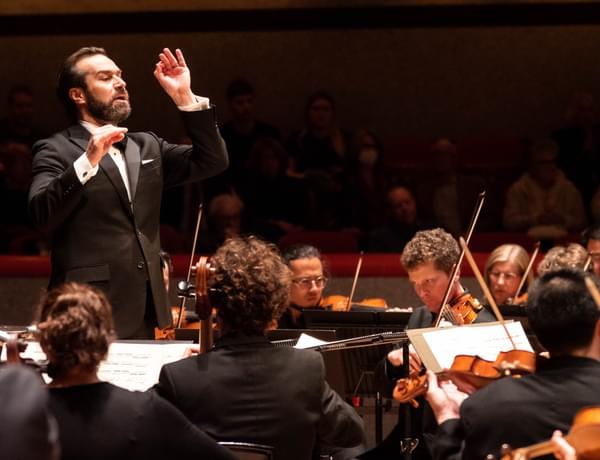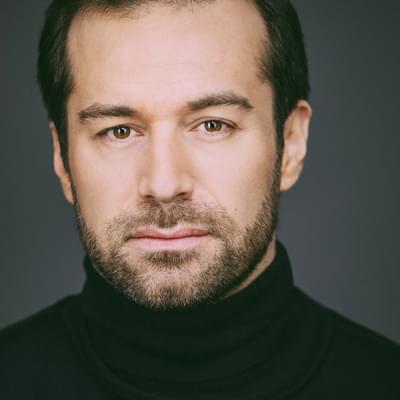Mozart & Shostakovich

Full programme
- Mozart, Ballet Music from Idomeneo (28mins)
- Mozart, Bassoon Concerto in Bb Major (18mins)
- Mark Simpson, Concertino for Trumpet and Orchestra (UK Premiere) (16mins)
- Shostakovich, Symphony No.9 (27mins)
Performers

Fabien Gabel
Conductor
Nikolaj Henriques
Bassoon
Jason Lewis
Trumpet
Introduction
Welcome to our first matinee performance of the season, where Mozart dances, Simpson dazzles, and Shostakovich has a blast.
The Mozart Bassoon Concerto is by far the most famous solo piece written for the bassoon. As bassoonists we have to play it in every audition when we apply for a job, so I have spent many years focusing on the difficult passages and the technical aspects of the piece. It is so wonderful to play it, being allowed only to focus on the music and have a party with this beautiful, lyrical and, at times, funny piece.
The preparation to play the concerto comes in stages. Firstly I started practicing it when I was around 14 years old, and then continued to develop it through my studies until playing it at my CBSO audition in 2018. After that I didn’t touch it for a couple of years, until playing it with the CBSO in 2020.
This time around I have approached it with new ideas, all fresh cadenzas and I looking forward to share this interpretation with you!
Back when this piece was written, the tradition was to quote the other pieces performed in the concert. So listen out if you recognise something familiar.
Fun fact: Mozart actually reused some of the theme from the second movement in his opera ‘the Marriage of Figaro’. So have a listen to the aria ‘Porgi Amor’ and see if you hear the similarities. I recommend the recording by Kiri Te Kanawa, I’m very inspired by the way she sings it.
Nikolaj Henriques
Section Leader Bassoon
I’ve heard a lot of Mark Simpson’s music, and it’s always brilliant, crazy, and virtuosic – but this fabulous trumpet Concertino was totally new to me!
Preparing the piece has been both exciting and challenging. As you will hear, it’s very physically demanding for a brass player, the range and sheer number of notes makes it difficult to practise for any length of time. So, since about February this year I’ve been chipping away little and often – trying to get the different intervals in my head so I can pitch them more easily, whilst at the same time trying to build my stamina up to be able to get though the piece in its entirety. Doing all this in addition to keeping up with the CBSO schedule has been quite demanding – but I’m hopeful I’ll manage to do justice to this great piece.
As you listen, you will quickly become aware of the range of exciting sound effects Mark uses throughout the piece (like flutter tongue, double tonguing, plunger mute and Harmon mutes), not to mention the use of the complete range of the trumpet. The piece is really varied and I’m so happy to finally hear it with the orchestra and to hear all the amazing sounds and textures they are creating too!
Jason Lewis
Section Leader Trumpet
Programme Notes
Idomeneo, a story of kings, queens and Gods, is given a suitably noble treatment by Mozart, while his Concerto for Bassoon featuring CBSO’s Nikolaj Henriques, is as light and delicious as a soufflé. Simpson’s fabulous Trumpet Concertino, by turns sassy and slinky, gives the spotlight to CBSO’s Jason Lewis, while Shostakovich’s pithy Symphony No.9 goes from sprightly to feverish to downright raucous.
Ballet music for Idomeneo, K.367
Wolfgang Amadeus Mozart (1756-1791)
Idomeneo was the biggest break of Mozart’s youthful career. An opera commissioned by the Elector of Bavaria himself, to be performed in his capital of Munich during the Carnival season of 1781, and played by the word-famous Mannheim court orchestra (recently relocated, and full of Mozart’s closest musical friends and admirers): what better showcase for a 25-year old court organist from the depressingly provincial city of Salzburg!
But he wasn’t alone. 18th century operas, like modern West End musicals, were collaborative projects, and there were regular meetings with his creative partners, including the ballet master, Claude Le Grand. “He’s an insufferable windbag and bore” Mozart confided to his father, “and with all his babble he made me miss the mail coach”. But ballet was a non-negotiable part of any serious opera in the 1780s, and while Mozart may have found it trying (“those confounded dances!”), he knuckled down and delivered.
He did, however, insist on one point. Ballet music for operas was usually written by a different composer. Mozart wasn’t having that, and he did the job himself – and in grand style. The whole corps de ballet took the stage whenever the majestic Chaconne re-appears; it blazes to a finish, and a grandiose flourish and swaggering trumpets announce a solo turn (Pas seul) for M. Le Grand himself. A flowing Passe-pied and a shapely Gavotte are courtly dances (though Mozart charges them with drama) and the final Passecaille closes the ballet softly. Everyone, in short, gets to put their best foot forward.
Bassoon Concerto in B flat, K.191
Idomeneo wasn’t Mozart’s first time in Munich. In January 1775 he’d celebrated his 19th birthday in the Bavarian capital; it was carnival season, and although he’d had a spot of toothache, he was thoroughly enjoying himself. “As for our travel home, well, we’re not in a hurry to come back” he wrote to his mother back in Salzburg. It was probably around this time that Mozart met the nobleman and amateur bassoonist Baron Thaddäus von Dürnitz. Some believe that Mozart wrote his Bassoon Concerto specially for Dürnitz; though the earliest sources gives its date of completion as “Salzburg, 4th June 1774” - in other words, the previous summer, when Mozart was 18, and several months before he’s likely to have met the bassoon-loving Baron.
But whatever the circumstances, the Bassoon Concerto is a superb little piece of musical craftsmanship. After all, how do you create an orchestral setting for an instrument whose voice is quiet, dark and low? Mozart equips his orchestra with pairs of oboes and horns – whose high, brilliant sound keeps well out of the bassoon’s way. The brisk, march-like themes of the first movement lend themselves perfectly to the bassoon’s signature brand of bustle (as well as permitting a certain dignity). In the slow movement, Mozart creates space for the bassoon to sing from its poetic soul. His closing Rondo is a stately minuet – but one that allows the soloist to demonstrate all their agility and wit before sweeping to a grand (but always graceful) close.
Concertino for Trumpet and Orchestra (2021)
Mark Simpson (b.1988)
Mark Simpson is a virtuoso clarinettist - he cut his teeth (like Sir Simon Rattle) in Liverpool’s Merseyside Youth Orchestra. Since winning BBC Young Musician in 2006, he’s emerged as a new kind of composer: one who charges classical forms with a distinctly Northern energy - the sound of a landscape where pop music pulses through rainy, neon-lit nights. His music ranges from lush, exuberant concertos for cello and violin to the oratorio The Immortal (a sensation at the 2015 Manchester International Festival) and the opera Pleasure, set in a gay nightclub. But his Trumpet Concertino is his first work for a brass instrument and orchestra, and in his own words…
"The first movement begins with a quick orchestral explosion from which the trumpet emerges with wild material, alternating these outbursts with more lyrical passages. The second movement is slow and expressive, the quasi-improvisatory music twists and winds around a simple, moving bed of harmony in the strings. The section ends with an orchestral chorale."
"The third movement is playful and fun. Stabbing gestures in the orchestra are punctuated by runs and jumps in the solo trumpet part. The final movement is the longest and most expressive. It begins with a simple melody in the trumpet which opens out into something darker and pained. This is followed by a struggle between the soloist and orchestra, building to an intense climax. As the dust settles the trumpet murmurs through the orchestral texture. We then revisit the chorale material from the end of the second movement which grows to a final crescendo."
Symphony No.9 in E flat major Op.70
Dmitri Shostakovich (1906-1975)
On 8th May 1945, the Soviet Union and its allies accepted the unconditional surrender of Nazi Germany. Soviet artists knew what was expected of them, and it so happened that Dmitri Shostakovich’s next symphony would be his Ninth: a significant moment for any composer. Beethoven’s Ninth was the benchmark: an uplifting and monumental masterpiece seemed in order, and Shostakovich had already announced that “I would like to employ not only full orchestra but also choir and soloists”. He seems to have composed part of just such a work in early 1945. The Soviet news agency TASS announced that he would shortly complete a symphonic “celebration of our great victory”.
But the Ninth Symphony that a Leningrad audience heard for the first time on 20th November 1945 was no towering hymn of victory. There was no choir. In fact, it was Shostakovich’s shortest symphony – and his most cheerful in a very long time. “Musicians will like to play it, and critics will delight in damning it” predicted Shostakovich and the official line, briefly, was that Shostakovich was expressing his joy at the victory. But the authorities quickly smelled a rat. “Is it the right time for a great artist to go on vacation, to take a break from contemporary problems?” asked the state-sanctioned critic Izrail Nestyev, ominously.
Shostakovich was too sensible to give much away in public, but he told a friend that his Ninth Symphony was “pseudo-comic” – and over its five movements there’s much more going on than meets the innocent ear. The crisp, playful first theme blows a raspberry before the end of its fourth bar: a trombone blusters pompously in with two notes, as if starting a great oration, then gets stuck, repeating its own pompous cliché. Meanwhile martial drums strike up and the piccolo whistles a jaunty march. It’s more like a circus than a victory parade, and a solo violin rams the joke home as the movement speeds to its close. But there are some worryingly dark clouds along the way.
The rest of the symphony lets us draw our own conclusions. In the Moderato, the clarinet leads a melancholy song that gradually grows into a ghostly waltz (the piccolo has the last word). The whirling, musical-box central scherzo (Presto), meanwhile, opens in real (if hectic) joy, before the colour drains from the music’s cheeks. Suddenly, there’s an ominous hush and massive, sombre brass chords rear up like cenotaphs (Largo). The bassoon tries to speak out in the silence, then gradually starts whistling another one of those silly march tunes (Allegretto). Tentatively, the orchestra joins in and momentum builds as the music accelerates into a headlong, bristling, finale. Carnival parade, or something less innocent? Stalin’s régime came to its own conclusions, and banned the symphony outright in February 1948.
© Richard Bratby
Featured image © Hannah Fathers